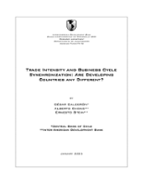Trade Intensity and Business Cycle Synchronization: Are Developing Countries any Different?
Date
Jan 2003
Data
Some key criteria in the optimal currency area literature are that countries should join a currency union if they have closer international trade links and more symmetric business cycles. However, both criteria are endogenous. Frankel and Rose (1998) find that trade intensity increases cycle correlation among industrial countries. We study whether the same result holds true for the case of developing countries, as their different patterns of international trade and specialization may lead to cyclical asymmetries among them and between industrial and developing countries. We gather annual information for 147 countries for 1960-99 (33,676 country pairs) and find: (i) countries with higher bilateral trade exhibit higher business cycle synchronization, with an increase of one standard deviation in bilateral trade intensity raising the output correlation from 0.05 to 0.09 for all country pairs; (ii) countries with more asymmetric structures of production exhibit a smaller business cycle correlation; (iii) the impact of trade integration on business cycles is higher for industrial countries than both developing and industrial-developing country pairs; (iv) a one standard deviation increase in bilateral trade intensity leads to surges in output correlation from 0.25 to 0.39 among industrial countries, from 0.08 to 0.10 for our sample of industrial-developing country pairs, and from 0.03 to 0.06 among developing countries; (v) the impact of trade intensity on cycle correlation is smaller the greater the production structure asymmetries between the countries.




